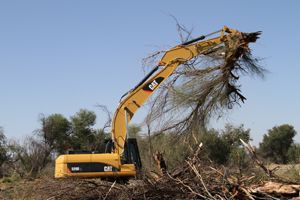Armed with a specialized work tool, a Cat 329D L excavator clears the way for cattle grazing in Namibia's beef heartland.
A flowering tree, the Prosopis species was introduced to Namibia as a shade tree in the 1900s. Since then, it has adapted well to the country's arid climate, aggressively taking hold across the landscape, increasingly at the expense of local eco-systems and commercial agriculture. This is particularly the case for cattle grazing, where past expansive grasslands have been steadily replaced by dense-growing, water-hungry Prosopis stands.
In Namibia's arid regions, there are often "feast or famine" rainfall trends that have long cycle times, sometimes lasting up to 16 years, so the timing of when to invest in new livestock is critical.
For example, take the Prinsloo family's farm Donnersberg in the Omaheke region, the Western extension of the Kalahari Desert. Based on past experience and aerial surveys, the Prinsloos believe that the time for the next drought period is approaching. Now, the task of preparing for this negative weather window rests with Kobus Prinsloo, whose father first broke new ground at Donnersberg in the 1970s. The main goal was to clear 150 hectares of Prosopis trees from their farmland. The first step was to determine the best extinguishing method.
Tree removal options include burning or poisoning, but neither is efficient or practical from a land clearing perspective. Their sheer numbers also rule out any attempt to dig trees out by hand, so the best approach by far is the use of mechanization, an area where Kobus Prinsloo has extensive experience. Head of Prinsloo Drilling and based in Windhoek, Kobus leads a contracting company that has completed landmark mining exploration and potable borehole drilling projects across southern Africa during the past 20 years.
Working with the Windhoek branch of Cat® dealer Barloworld Equipment, Kobus had an idea to source a machine that could excavate, grab, rip and move Prosopis trees straight out of the ground. Retired Barloworld Equipment Cat sales professional, Knoppies Knobloch, played a key role in developing the final solution.
"What we came up with is a Cat 329D L hydraulic excavator equipped with a specialized forestry Cat work tool and factory-fitted with the necessary hydraulic line connections," explained John Hosking, Barloworld Equipment Namibia general manager.
The Cat 329D L is the ideal workhorse for this application. With an operating weight of around 30 tons, the 329D L is powered by a Cat C7 ACERT™ engine, generating a maximum output of 128 kW. Both for performance and safety, the excavator's reach boom is fitted with a longer-than-standard 3.2-meter stick to achieve extra length and height.
During a recent demonstration for local farmers at farm Donnersberg, the machine was put through its paces. Those attending were impressed with the ease and speed of removing mature, firmly rooted Prosopis trees. "Seeing is believing, and the end results have met and exceeded our expectations. Once we've cleared our own land, we hope to offer this service to other farmers and environmental agencies both locally and further afield in Namibia," said Prinsloo.
The solution going forward, however, is one of controlled removal. Harvested trees still have socio-economic value, both for farmers and local communities. Prosopis wood, for example, is harder than oak and suitable for making furniture, general carpentry, fuel and charcoal production. "Reducing their number from 100 trees per hectare to 10 will minimize their environmental impact so they can still be used for their commercial value rather than totally eradicated," added Prinsloo.
The preceeding article appears courtesy of Barloworld Equipment.


